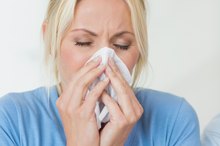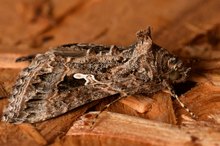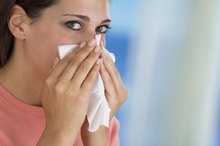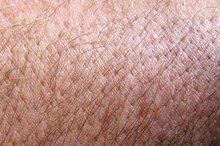What does fact checked mean?
At Healthfully, we strive to deliver objective content that is accurate and up-to-date. Our team periodically reviews articles in order to ensure content quality. The sources cited below consist of evidence from peer-reviewed journals, prominent medical organizations, academic associations, and government data.
The information contained on this site is for informational purposes only, and should not be used as a substitute for the advice of a professional health care provider. Please check with the appropriate physician regarding health questions and concerns. Although we strive to deliver accurate and up-to-date information, no guarantee to that effect is made.
Allergies That Cause Facial Breakouts
Allergy symptoms most often arise in the area near where the allergenic substance was ingested. For instance, an allergenic insect sting on the hand may produce swelling at the sting site, while facial contact with allergens most often results in facial breakouts. Allergens that are also inhaled may produce respiratory problems as well. Allergic reactions to many different materials can cause redness, itching and scaly or bumpy skin. When patients experience these symptoms alone, allergic contact dermatitis is a likely diagnosis 2. In combination with other physical reactions, facial breakouts may signify more serious allergy conditions.
Toxic Plant Allergies
Toxic plants such as poison ivy cause contact allergies only where their hazardous resins touch the body and become ingested through skin absorption. While gardeners or hikers may expose their faces to these plants, they can also transfer the plant resins via facial contact with contaminated items or even pets. Touching plants with the hands and then scratching the face can also spread the painful rash. The University of Maryland (UM) Medical Center reports that facial allergy symptoms from poison ivy, poison oak and poison sumac include red streaks, raised bumps and severe itching.
- Toxic plants such as poison ivy cause contact allergies only where their hazardous resins touch the body and become ingested through skin absorption.
- While gardeners or hikers may expose their faces to these plants, they can also transfer the plant resins via facial contact with contaminated items or even pets.
Pet Allergies
Detergent Allergy Symptoms
Learn More
Pets' fur or feathers can become coated with allergens that cause contact allergies in some people. Chemicals in pet dander, saliva and urine produce allergic reactions when patients contact or inhale these substances, which may dry on pets’ bodies and become invisible. According to the Mayo Clinic, petting dogs, cats, birds or other warm-blooded animals and then touching the face or having direct facial contact with animals can trigger skin allergy symptoms 12. Itchy rashes from pet contact allergies tend to form red, patchy hives, rather than smaller bumps on the skin.
- Pets' fur or feathers can become coated with allergens that cause contact allergies in some people.
- Chemicals in pet dander, saliva and urine produce allergic reactions when patients contact or inhale these substances, which may dry on pets’ bodies and become invisible.
Chemical Allergies
Contact allergies to many chemicals found in everyday household and skin care products can also cause facial breakouts. The UM Medical Center notes that one of many ingredients in solvents, detergents and adhesives can provoke allergic reactions upon facial contact. Patients may also experience allergy symptoms from perfumes, deodorants and the active ingredients in topical medicines that touch the face, often without knowing the specific sources of their rashes. Allergenic cosmetics, soaps, detergents and sunscreens may contact the face directly or be transferred via clothing or pillow cases. As the American Academy of Dermatology reports, chemicals in fragrances, dyes and preservatives most often elicit allergic reactions to skin care products.
- Contact allergies to many chemicals found in everyday household and skin care products can also cause facial breakouts.
- The UM Medical Center notes that one of many ingredients in solvents, detergents and adhesives can provoke allergic reactions upon facial contact.
Related Articles
References
- Mayo Clinic: Pet Allergy
- Mayo Clinic: Contact Dermatitis
- American Academy of Dermatology. Contact dermatitis.
- Saito M, Arakaki R, Yamada A, Tsunematsu T, Kudo Y, Ishimaru N. Molecular mechanisms of nickel allergy. International Journal of Molecular Sciences. 2016;17(2):202. doi:10.3390/ijms17020202
- Uter W, Werfel T, White IR, Johansen JD. Contact allergy: A review of current problems from a clinical perspective. Int J Environ Res Public Health. 2018;15(6). doi:29844295
- American Academy of Dermatology. Poison ivy, oak, and sumac: What does the rash look like?
- Goon AT, Goh CL. Plant dermatitis: Asian perspective. Indian J Dermatol. 2011;56(6):707-10. doi:10.4103/0019-5154.91833
- Rozas-muñoz E, Lepoittevin JP, Pujol RM, Giménez-arnau A. Allergic contact dermatitis to plants: understanding the chemistry will help our diagnostic approach. Actas Dermo-sifiliogr. 2012;103(6):456-77.
- Cleveland Clinic. Contact dermatitis. Last reviewed October 10, 2019.
- Mukkanna KS, Stone NM, Ingram JR. Para-phenylenediamine allergy: Current perspectives on diagnosis and management. J Asthma Allergy. 2017;10:9-15. doi:10.2147/JAA.S90265
- Antoniou C, Kosmadaki MG, Stratigos AJ, Katsambas AD. Sunscreens--What's important to know. J Eur Acad Dermatol Venereol. 2008;22(9):1110-8. doi:10.1111/j.1468-3083.2007.02580.x
- Moreira J, Gonçalves R, Coelho P, Maio T. Eyelid dermatitis caused by allergic contact to acrylates in artificial nails. Dermatol Reports. 2017;9(1):7198. doi:10.4081/dr.2017.7198
- Rai R, Dinakar D, Kurian SS, Bindoo YA. Investigation of contact allergy to dental materials by patch testing. Indian Dermatol Online J. 2014;5(3):282-6. doi:10.4103/2229-5178.137778
- Skypala I, Durham S, Scadding G. Immediate-type food allergy to balsam of Peru. Clinical and Translational Allergy. 2011;1(Suppl 1). doi:10.1186/2045-7022-1-s1-o39.
- Teo WZW, Schalock PC. Metal hypersensitivity reactions to orthopedic implants. Dermatol Ther (Heidelb). 2017;7(1):53-64. doi:10.1007/s13555-016-0162-1
- Lampel HP, Silvestri DL. Systemic contact dermatitis: Current challenges and emerging treatments. Curr Treat Options Allergy. 2014; 1: 348. doi:10.1007/s40521-014-0029-6
- Winnicki M, Shear NH. A systematic approach to systemic contact dermatitis and symmetric drug-related intertriginous and flexural exanthema (SDRIFE): a closer look at these conditions and an approach to intertriginous eruptions. Am J Clin Dermatol. 2011;12(3):171-80. doi:10.2165/11539080-000000000-00000
- Winnicki M, Shear NH. A systematic approach to systemic contact dermatitis and symmetric drug-related intertriginous and flexural exanthema (SDRIFE). American Journal of Clinical Dermatology. 2012;12(3):171-180. doi:10.2165/11539080-000000000-00000.
- Contact Dermatitis. MedlinePlus NIH.
- Schnuch A, Westphal G, Mössner R, Uter W, Reich K. Genetic factors in contact allergy—review and future goals. Contact Derm. 2011;64(1):2-23. doi:10.1111/j.1600-0536.2010.01800.x
Writer Bio
Nancy Clarke began writing in 1988 after achieving her Bachelor of Arts in English and has edited books on medicine, diet, senior care and other health topics. Her related affiliations include work for the American Medical Association and Oregon Health Plan.









